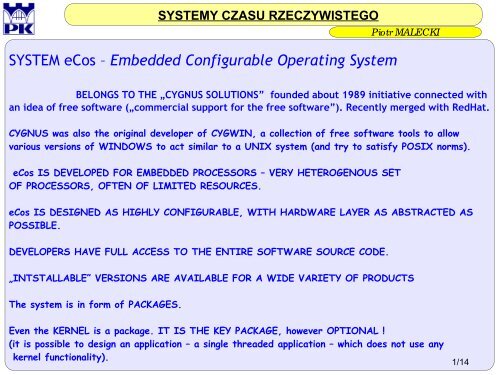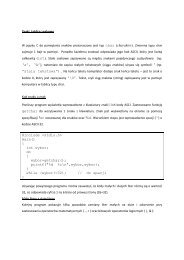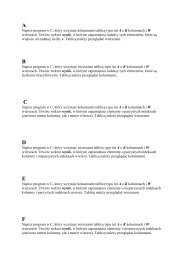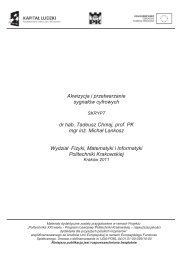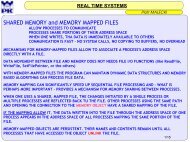SYSTEM eCos – Embedded Configurable Operating System - MARS
SYSTEM eCos – Embedded Configurable Operating System - MARS
SYSTEM eCos – Embedded Configurable Operating System - MARS
Create successful ePaper yourself
Turn your PDF publications into a flip-book with our unique Google optimized e-Paper software.
<strong>SYSTEM</strong>Y CZASU RZECZYWISTEGO<br />
<strong>SYSTEM</strong> <strong>eCos</strong> <strong>–</strong> <strong>Embedded</strong> <strong>Configurable</strong> <strong>Operating</strong> <strong>System</strong><br />
Piotr MALECKI<br />
BELONGS TO THE „CYGNUS SOLUTIONS” founded about 1989 initiative connected with<br />
an idea of free software („commercial support for the free software”). Recently merged with RedHat.<br />
CYGNUS was also the original developer of CYGWIN, a collection of free software tools to allow<br />
various versions of WINDOWS to act similar to a UNIX system (and try to satisfy POSIX norms).<br />
<strong>eCos</strong> IS DEVELOPED FOR EMBEDDED PROCESSORS <strong>–</strong> VERY HETEROGENOUS SET<br />
OF PROCESSORS, OFTEN OF LIMITED RESOURCES.<br />
<strong>eCos</strong> IS DESIGNED AS HIGHLY CONFIGURABLE, WITH HARDWARE LAYER AS ABSTRACTED AS<br />
POSSIBLE.<br />
DEVELOPERS HAVE FULL ACCESS TO THE ENTIRE SOFTWARE SOURCE CODE.<br />
„INTSTALLABLE” VERSIONS ARE AVAILABLE FOR A WIDE VARIETY OF PRODUCTS<br />
The system is in form of PACKAGES.<br />
Even the KERNEL is a package. IT IS THE KEY PACKAGE, however OPTIONAL !<br />
(it is possible to design an application <strong>–</strong> a single threaded application <strong>–</strong> which does not use any<br />
kernel functionality).<br />
1/14
<strong>SYSTEM</strong>Y CZASU RZECZYWISTEGO<br />
<strong>SYSTEM</strong> <strong>eCos</strong> <strong>–</strong> <strong>Embedded</strong> <strong>Configurable</strong> <strong>Operating</strong> <strong>System</strong><br />
KERNEL FUNCTIONALITY:<br />
Piotr MALECKI<br />
- NEW THREAD CREATION (at startup or when the system is running)<br />
- CONTROL OF THREADS AND PRIORITY MANIPULATION<br />
- SCHEDULER POLICY SELECTION<br />
- SYNCHRONIZATION OF THREADS WITH A HELP OF WIDE RANGE OF TOOLS<br />
- HANDLING OF INTERRUPTS AND EXCEPTIONS<br />
The <strong>eCos</strong> kernel DOES NOT provide memory allocation functions or device drivers.<br />
The memory allocation is handled by a separate package.<br />
Device drivers are separated from the <strong>eCos</strong> kernel to satisfy the postulate of the maximal<br />
hardware abstraction .<br />
One can design a single threaded application which DOES NOT use kernel functionality<br />
(kernel package) at all <strong>–</strong> but still profit from other packages of the <strong>eCos</strong>. Typically, such polling<br />
loop organization of a thread permanently checks all device flags and takes relevant actions to<br />
service I/O requirements. Any amount of calculation in each iteration increases the delay between<br />
events, eventually leading to an error.<br />
Some advanced packages (e.g. TCP/IP stack) require multi-treading internally and then the<br />
kernel package is NOT optional.<br />
2/14
<strong>SYSTEM</strong>Y CZASU RZECZYWISTEGO<br />
<strong>SYSTEM</strong> <strong>eCos</strong> <strong>–</strong> <strong>Embedded</strong> <strong>Configurable</strong> <strong>Operating</strong> <strong>System</strong><br />
Piotr MALECKI<br />
SCHEDULERS:<br />
Schedulers are needed when system serves multiple threads. <strong>eCos</strong> kernel may run one of two<br />
schedulers: BITMAP scheduler and Multi-Level Queue scheduler (MLQ). Both use simple<br />
numerical priorities. The default range of priority levels is 32. That can be changed by the<br />
CYGNUM_KERNEL_SCHED_PRIORITIES option.<br />
Level 0 is the highest priority.<br />
BITMAP scheduler allows for one and only one thread per priority level. For the default case it<br />
means that the system may be configured with the 32 threads maximum.<br />
BITMAP scheduler keeps track of threads which are currently runnable, identifies the one with the<br />
highest priority and similarly cares for those waiting for synchronization (semaphore, mutex or other<br />
primitive). Such indexing is simple and fast.<br />
BITMAP scheduler does not support timeslicing so, consequently, the current thread can not be<br />
preempted in favour of another thread with the same priority. This makes the BITMAP scheduler<br />
totally deterministic.<br />
3/14
<strong>SYSTEM</strong>Y CZASU RZECZYWISTEGO<br />
<strong>SYSTEM</strong> <strong>eCos</strong> <strong>–</strong> <strong>Embedded</strong> <strong>Configurable</strong> <strong>Operating</strong> <strong>System</strong><br />
Piotr MALECKI<br />
SCHEDULERS (cont.):<br />
MLQ scheduler allows to configure the system with multiple threads with the same priority.<br />
There is no limit on the number of threads in the system then. Other limitations <strong>–</strong> e.g. available<br />
memory <strong>–</strong> are, of course, possible.<br />
MLQ scheduler supports TIMESLICING, which is controlled by options, like<br />
CYGSEM_KERNEL_SCHED_TIMESLICE<br />
CYGNUM_KERNEL_SCHED_TIMESLICE_TICKS<br />
When active, the scheduler automatically switches from one runnable thread to another one with the<br />
same priority after some number of clock ticks.<br />
Timeslicing is operational only when there are two runnable threads with the same priority and no<br />
runnable one with the higher priority.<br />
Timeslicing can be disabled and then the thread will not be preempted. It continue running until<br />
explicitly yields the control to the processor or is blocked (e.g. waiting for mutex, semaphore ..)<br />
4/14
<strong>SYSTEM</strong>Y CZASU RZECZYWISTEGO<br />
<strong>SYSTEM</strong> <strong>eCos</strong> <strong>–</strong> <strong>Embedded</strong> <strong>Configurable</strong> <strong>Operating</strong> <strong>System</strong><br />
Piotr MALECKI<br />
SCHEDULERS (MLQ cont.):<br />
The default behaviour of the MLQ scheduler when threads are blocked is that it uses the<br />
last-in-first-out queueing. It means that when several threads waits on the semaphore and<br />
one post is released then the woken up thread is the last one which called cyg_semaphore_wait<br />
function. That makes queueing and dequeueing fast but <strong>–</strong> if waiting threads are of different<br />
priorities <strong>–</strong> then the first woken up thread may not be the one with the highest priority.<br />
The option CYGIMP_KERNEL_SCHED_SORTED_QUEUE, when enabled, allows to require the strict<br />
priority queueing.<br />
SYNCHRONIZATION PRIMITIVES:<br />
mutexes<br />
condition variables<br />
counting semaphores<br />
mail boxes<br />
event flags<br />
5/14
<strong>SYSTEM</strong>Y CZASU RZECZYWISTEGO<br />
<strong>SYSTEM</strong> <strong>eCos</strong> <strong>–</strong> <strong>Embedded</strong> <strong>Configurable</strong> <strong>Operating</strong> <strong>System</strong><br />
Piotr MALECKI<br />
SYNCHRONIZATION PRIMITIVES (CONT.):<br />
MUTEXES have a distinguished function in <strong>eCos</strong>: allow safe share of resources by multiple threads.<br />
The mutex is locked by the thread which manipulates the shared resource and then unlocks<br />
the mutex again.<br />
The other primitives are used for communication between threads or DSRs with the ISR or DSR with<br />
the thread itself.<br />
CONDITION VARIABLE can be used by a thread which has locked a mutex but needs to wait for some<br />
condition to become true. A thread WAITS ON condition variable until another thread<br />
or DSR (Deffered Service Routine) use to wake it up. N.B. when thread waits on Condition Variable it<br />
releases the mutex (before waiting) and reacquires it before processing. That is of<br />
delicate matter as it is important that no race conditions are introduced. Atomic operations and great<br />
care is needed!<br />
A COUNTING SEMAPHORE is used when one needs to communicate that certain event has ocuured, or<br />
that it has occurred multiple times in succession. The waiting thread is called the consumer thread<br />
while the thread (or DSR) which posts the event is called the producer.<br />
6/14
<strong>SYSTEM</strong>Y CZASU RZECZYWISTEGO<br />
<strong>SYSTEM</strong> <strong>eCos</strong> <strong>–</strong> <strong>Embedded</strong> <strong>Configurable</strong> <strong>Operating</strong> <strong>System</strong><br />
Piotr MALECKI<br />
SYNCHRONIZATION PRIMITIVES (CONT.):<br />
The count associated with the semaphore records occurrence of multiple events,<br />
which are not lost and allow for succession of multiple wait operations .<br />
MAIL BOXES similarly indicate occurrence of a particular event and at the same time allow to<br />
exchange some data item (often it is a pointer to some structure). The mail box has finite capacity<br />
and if producer generates mail box events faster than they are consumed then the mail box is blocked.<br />
Such feature usually eliminates mail boxes as a synchronization tools for the DSR <strong>–</strong> thread<br />
communication. They are typically used as a synchronization between threads.<br />
EVENT FLAGS are used to wait for (from the one hand side) or to signal (from the other) various<br />
events. For such communication one uses usually a bit masks, in which given bits are<br />
associated with particular events. With such simple construct there is no way to deal with multiple<br />
events <strong>–</strong> as in the case of counting semaphores.<br />
Similarly, unlike mail boxes, there is no way to pass any additional data. On the other hand<br />
one can use event flags for communication between DSR and threads as there is no danger of<br />
an overflow and a subsequent blockade.<br />
7/14
<strong>SYSTEM</strong>Y CZASU RZECZYWISTEGO<br />
<strong>SYSTEM</strong> <strong>eCos</strong> <strong>–</strong> <strong>Embedded</strong> <strong>Configurable</strong> <strong>Operating</strong> <strong>System</strong><br />
Piotr MALECKI<br />
INTERRUPT HANDLING:<br />
Treads and interrupt handlers interactions.<br />
- continuous polling of a volatile variable<br />
- polling on every clock tick (10 ms)<br />
- use of some synchronization primitive<br />
Problem with possible kernel data corruption.<br />
<strong>eCos</strong> two-level approach to interrupt handling: ISR and DSR.<br />
ISR <strong>–</strong> fast Interrupt Service Routine <strong>–</strong> direct response to a „Interrupt Vector”<br />
Efficient service with minimal references to the system leaving the rest of the service<br />
to<br />
DSR <strong>–</strong> Deferred Service Routine which completes the interrupt service which may require<br />
much more system calls (via e.g. using condition variables or by posting<br />
a semaphores. It is also DSR which is supposed to contact the thread (e.g. to wake<br />
it up)<br />
There are practices of disabling interrupts preventing the ISR from running <strong>–</strong> rather bad practise<br />
and should be used only for a very short periods of time and only for really necessary actions<br />
(like manipulating list of free buffers ...<br />
8/14
<strong>SYSTEM</strong>Y CZASU RZECZYWISTEGO<br />
<strong>SYSTEM</strong> <strong>eCos</strong> <strong>–</strong> <strong>Embedded</strong> <strong>Configurable</strong> <strong>Operating</strong> <strong>System</strong><br />
Piotr MALECKI<br />
INTERRUPT HANDLING (cont.):<br />
Somehow similar problem <strong>–</strong> to the question of interrupts being enabled or disabled -<br />
is the problem of the kernel scheduler lock.<br />
Scheduler may be locked in response to function like:<br />
cyg_mutex_lock<br />
cyg_semaphore_post<br />
which may be issued by the kernel for time of manipulation with some data structures<br />
after which the lock is released.<br />
Locking the scheduler may cause pending some DSRs and some chain of synchronization events<br />
influencing waking up of threads of various priorities.<br />
... various possible scenarios ...<br />
in which one can illustrate that the two-level approach to interrupt handling realised by <strong>eCos</strong><br />
allows fo safe solutions ( .. e.g. it is safer to leave cyg_semaphore_post to a DSR rather than<br />
to ISR which disabling interrupts may cause corruption of kernel data structure or even loss<br />
of some thread that would never run again).<br />
9/14
<strong>SYSTEM</strong>Y CZASU RZECZYWISTEGO<br />
<strong>SYSTEM</strong> <strong>eCos</strong> <strong>–</strong> <strong>Embedded</strong> <strong>Configurable</strong> <strong>Operating</strong> <strong>System</strong><br />
Piotr MALECKI<br />
SMP ( Symmetric Multiprocessing <strong>System</strong>s) SUPPORT<br />
(available only on some selected architectures and platforms)<br />
- The main startup takes place on only one CPU („primary” CPU)<br />
- All other CPUs are either suspended or “captured” by HAL<br />
- Primary CPU <strong>–</strong> after some initializations <strong>–</strong> calls cyg_start to enter the application<br />
- Secondary CPUs are initialized ONLY when an application calls cyg_scheduler_start<br />
(this routine scans the list of available secondary CPUs and invokes<br />
HAL_SMP_CPU_START to start each CPU<br />
and then calls an internall function Cyg_Scheduler::start_cpu to enter the<br />
Scheduler for the primary CPU)<br />
- Each secondary CPU starts in the HAL, completes initialization at calls kernel at<br />
cyg_kernel_cpu_startup , claims the scheduler lock and calls<br />
Cyg_Scheduler::start_cpu , which is common for all CPUs. Now an interrupt object<br />
Is installed for inter-CPU interrupts and after that all CPU are equal.<br />
(Some hardware may still distinguish them delivering interrupts)<br />
10/14
<strong>SYSTEM</strong>Y CZASU RZECZYWISTEGO<br />
HAL Hardware Abstraction Layer<br />
Piotr MALECKI<br />
eCOS is written mostly in C++ - HAL: in C and assembler<br />
BASE DEFINITIONS<br />
ARCHITECTURE CHARACTERISATION<br />
INTERRUPT HANDLING<br />
CLOCK AND TIMERS<br />
HAL I/O<br />
CACHE CONTROL<br />
…<br />
BASE: e.g. endianness (bit ordering), label translation, type definitions, …<br />
ARCHITECTURE: register save format, thread context initialisation and switching, stack sizes,<br />
address translation, …<br />
INTERRUPT HANDLING: vector numbers, interrupt state control, ISR/VSR management,<br />
CLOCK and TIMERS: clock control, delay routines, clock frequency control, …<br />
HAL I/O: register address, register read, register write …<br />
CACHE CONTROL: cache dimension, global control <strong>–</strong> synchronize, write, lock, unlock ...<br />
11/14


